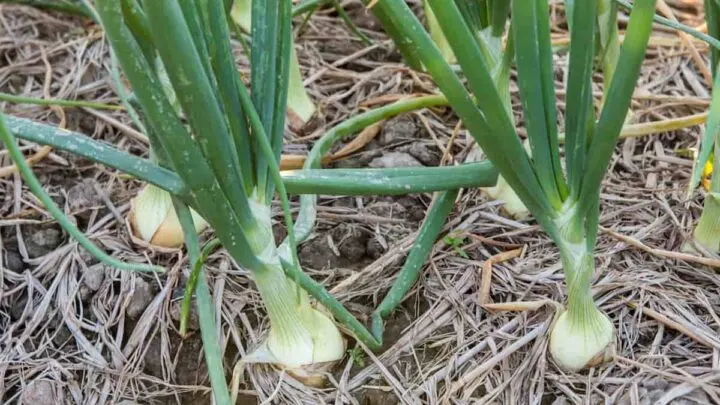Growing onion plants is mostly simple when things are going well. However, when the plant starts to encounter some issues, particularly with how it looks while it’s growing, it can be concerning. One thing I’ve noticed while growing onions (and I know of other gardeners too) is curling. Typically I’ve seen this on the tops of the onion, and sometimes near the bulb.
But, why would an onion start curling?
Onions tend to curl when pests have gotten inside and have altered the way it develops. Thrips can cause curling in onions by feeding on the newer leaves as well as the plant tissue. Other causes include nematodes, viruses, and overfertilization
In addition to curling, thrips can cause other types of damage to your onion plants; and in some cases cause it not to fully develop. Let’s get into a few other causes of curling leaves, and ways you can help your onion plant stay protected and thrive.

Other Causes Of Onion Curl
Although thrips and other pets such as leek moths and leak miners can cause onion curl, there are a few causes of onion curl.
Overfertilization
Fertilizing onions is mostly simple. They require lots of nitrogen in the beginning, and once they start building, you can lay off the fertilizer. However, because it’s an underground plant, it’s easy for gardeners to fertilize past that period. Also, some fertilizers may be too strong for your onion plant.
Onion Variety
Some onion varieties are more susceptible to pests and curling than others.
Nematodes
Nematodes can affect the stems and the bulbs.
Some of what you’ll notice about your plant include:
- Twisted and stunted leaves
- dried bulbs
- cracks in the bulb
Viruses
As with most plants, onions can run into a few viruses that cause leaf problems and curling.
Onion yellow dwarf virus for example can lead to leaf curling and crinkling. Eventually, all the leaves will start to be fully yellow. The bulb will also have an issue forming because the virus tends to affect the onion early. So you might see a twisted bulb, or even one slightly flattened and discolored.

Anthracnose
One cause not commonly mentioned is Anthracnose. This is something that not only affects onions but trees as well. The disease causes curling as well as leaf spotting and leaf drop. It can also affect the bulb of the plant.
In relation to the bulb, you may even see some lesions on the bulb in addition to the distortion. Thankfully, it’s easy to treat in most cases with fungicide sprays.
What Exactly Are Thrips And How Do They Cause Curling
Most onion curl is caused by thrips, but what are they exactly?
Thrips are tiny bugs, extremely thin in size, and are known to eat many plants. However the plants they tend to focus most on includes garlic, leeks, and of course; onions. They are often referred to as thunder flies.
Thrips cause most of their damage to onion plants by sucking on the plant cells. This means they can easily transmit diseases throughout the onion plant; which in most cases leads to deformity and curling.
You can usually tell when a thrip damages an onion because they always leave a trail. It’s often silver streaks or patches of white. Some of the damage you may see in addition to curling include:
- stunted growth
- wilting and distorted leaves
- browning or yellowing of the onion leaves
- Various spotting diseases including INSV, TSWV, and IYSV

Preventing Thrips From Eating Your Onion Plants
A big part of controlling thrips is through preventative measures. Below are some you can take before things turn into an infestation.
Use Sticky Traps
Using sticky traps is helpful in detecting thrips in the area. You can apply these not just directly to where your onion crops are, but to the edges of your home and garden area. As thrips come across the trap they’ll get stuck. If you notice a high number of them, then that’s a sign that they may be starting to show up!
Apply Insecticide
An insecticide is an easy way to get rid of thrips and other garden pests. I would suggest only applying this if you’re seeing 3 or more thrips per onion leaf. A foliar spray is probably the easy way to apply it to the onion.
Just be sure to cover in between the leaves as much as possible as thrips are tiny enough to hide there. The more towards the center of the plant you apply the spray, the better the results.
Removing Plant Debris
If you do a lot of crop rotation, then there could be thrips left over in that plant debris. So, to make things a bit easier, simply remove as much debris as you can. Whether that be dried leaves, mulch, or even old soil, it’s important to clear the area.

Hi there, my name is Allie and welcome to my blog; GareningWithAllie!
Much of what you see written here is just our personal experiences with gardening. Along with the content I write here, there is also a unique collection of gardening topics covered by some of our close friends. I hope you find everything you read here to be helpful, informative, and something that can make your gardening journey the most lovely experience ever! With that said, Happy Gardening!
